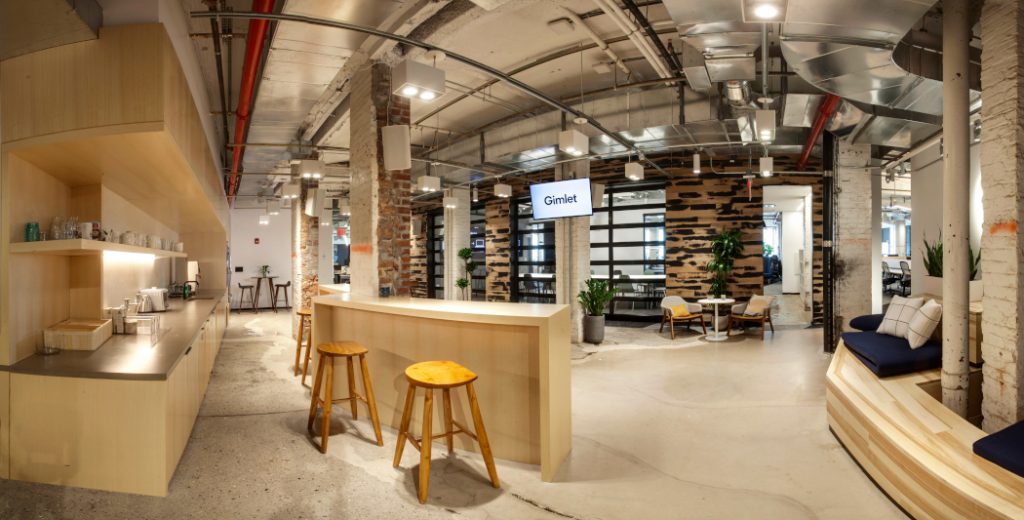Brooklyn NY has quickly become a major hub for media. The high-profile media brands that have set up home bases there include Kickstarter, Etsy, Vice Media, Amplify, creative agency Huge and leading streaming-media purveyor Livestream. Among the newest is Gimlet Media, the podcast network behind hit shows like “Reply All,” “Heavyweight” and “The Nod.” The 2014 startup has become the equivalent of Time-Life for podcasting. An estimated 46 million Americans have listened to those audio-centric serials at least once in any given month, according to Edison Research, which has been tracking podcast audiences for the past decade.
When Gimlet Media decided to move into a new headquarters last year—the company took over 27,000 square feet of space in a converted storage building that had undergone a $30 million makeover—it had to establish not only a workspace, but also a workflow.
“The key objectives here were flexibility and user friendliness,” Austin Thompson, Gimlet Media’s Technical Director, said. “We needed to be able to easily route audio and video between various types of rooms—team offices, conference rooms and studios—and we wanted to develop a system that producers could learn to use fluently with 20 minutes of training, rather than 20 hours.” Thompson laid out a vision that would have been challenging to execute in a spacious Silicon Valley campus, much less the far narrower confines of New York’s Silicon Alley real-estate environment.
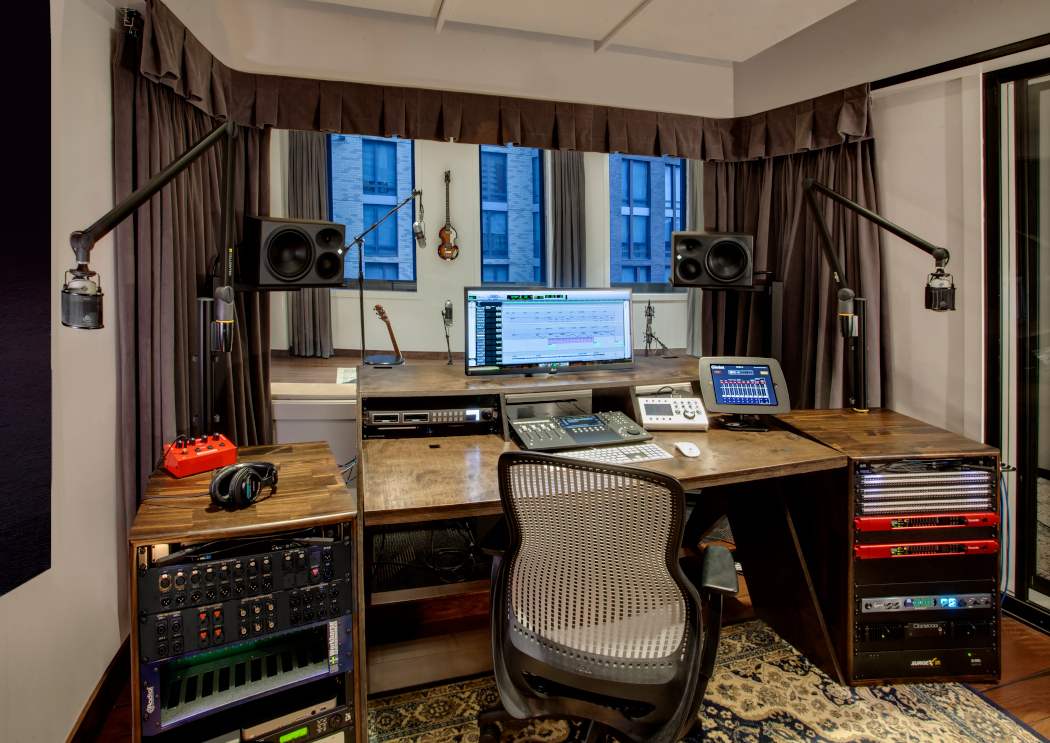
Nevertheless, that’s exactly what happened. “This is a combination office and production space where everything is interconnected and everything is incredibly intuitive to operate,” Matt Gajowniczek, President of Sound, Production & Lighting (SPL), the project’s AV integrator, stated. “Both the office part the project and the 13 production rooms share the same processor.” Namely, he’s referring to a pair of QSC Q-SYS Core 5200 units—one redundant and ready to take over automatically in a matter of seconds if the first should go offline.
“Everything is connected,” Gajowniczek continued. “You can call up audio from any room to any other room, from a studio to a conference room. Even the Shure ceiling-array microphones in the conference room can be routed to a studio if we want the meeting recorded.” Each room, whether used for production or meetings, has the same QSC wall-mounted control panel, giving each the same functionality over the AV systems; content from the Avid Pro Tools systems in each production room can be called up and played in any meeting space, whereas edits from any of four edit suites can be sent back to production for final mixes.
A Radical Departure
The integrator, based in the northern Chicago IL suburb of Skokie IL, was a surprising choice for the podcast empire, which was valued at $55 million at the time it signed its 10-year lease on the downtown Brooklyn space. Gajowniczek estimates his company’s annual turnover at less than $3 million, with its work split roughly evenly between local house of worship and corporate projects and work on national franchises, such as the Tin Roof restaurant and club chain, most recently in Delray Beach FL and Raleigh NC. Gajowniczek attributes the initial connection largely to serendipity: Thompson was a former SPL regular freelancer before coming aboard with Gimlet. That got SPL in the door, but, nevertheless, it took time, effort and ingenuity to convince the client that the integrator had a better way forward for the new facility’s AV systems.
“We were suggesting a fairly radical departure from the way podcasts had been done in the past,” Gajowniczek said. The podcasting world was divided into a few larger content developers that relied on conventional broadcasting hardware, such as radio consoles, to produce audio programs; on the other hand was the vast do-it-yourself side of the business, using a microphone and an interface to record into a laptop computer before streaming it out from garages and basements around the country. He said SPL worked on developing a universal solution, based on the QSC Q-SYS platform.
That solution would link Gimlet’s business operations side of the floor, boasting various meeting spaces and offices, with the company’s production side, which uses Apple MacBook Pro and iMac computers as recording and editing platforms for a Pro Tools 2018 system spread across 13 studios. There, Apple iPad Pro tablets are placed in lieu of consoles to manage the audio. The processing is all done centrally in the Q-SYS Core, which, according to Gajowniczek, renders workflows “mistake-proof.” Genelec and Neumann speakers are used throughout for monitoring. Neumann BCM 705 dynamic microphones are standard in every production studio, as are Focusrite Pro RedNet MP8R eight-channel microphone preamps/ADCs, all clocked through Studio Technologies Model 5401 Dante Master Clocks located in the main server room.
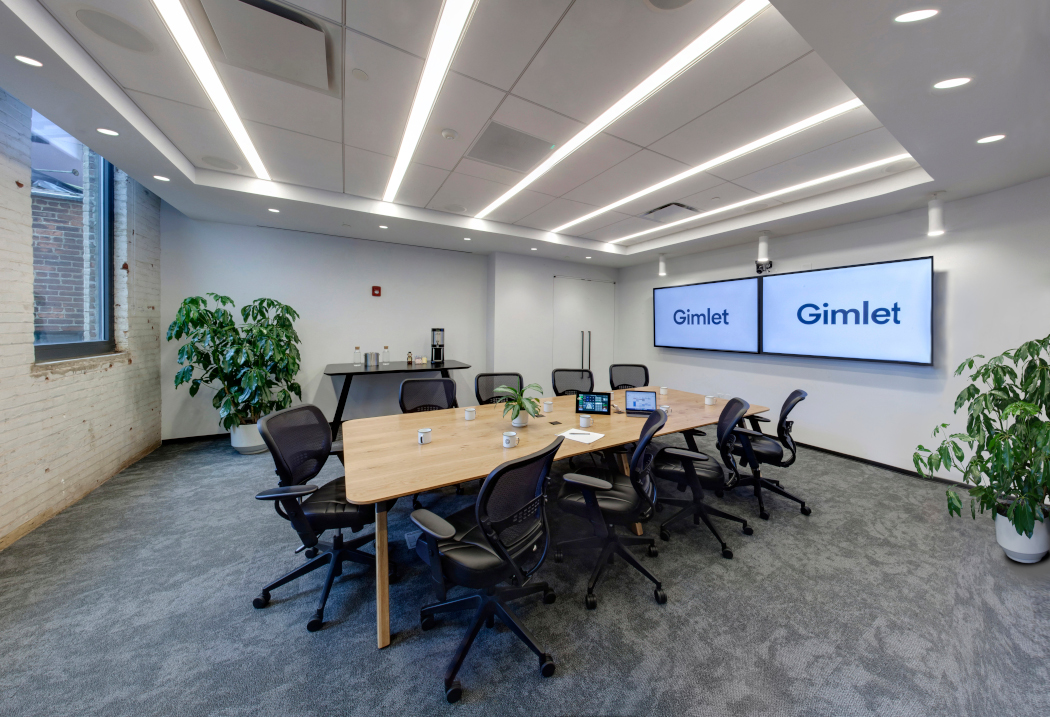
Gajowniczek put the ideas to Thompson in October 2017, and the two worked continuously on the concept before integration began the following April after the build-out was complete, ahead of the facility’s debut this past August. “Being a smaller company gave me the time to spend on thinking about what was the most functional, rather than just looking at the numbers,” Gajowniczek remarked. “We put it all together in an existing office space as a proof of concept. We wanted to make sure it gave them the workflow they needed, and that it was a combination of components that could be easily scaled.”
Indeed, it was, and those audio and control components are common to the facility’s main Studio A control room and a dozen smaller production rooms. Gajowniczek said that using the Q-SYS Core as the foundation for the concept helped sell the ideas to management, given that it could be applied to both the business and the production sides of the company. The integrator had to sell the idea that all the production rooms would use virtual control systems, managed through the iPads, instead of with physical faders and knobs, while also allowing users’ own devices, such as smartphones, to be part of the system. “A lot of the podcasting business is still very old school,” he revealed. “They like having faders.”
Thompson agreed, noting that Gimlet Media had already auditioned hardware from three major radio console manufacturers. But even as that was taking place, Gajowniczek and he were working on the scale model with the Q-SYS Core in an unused office in Gimlet Media’s previous headquarters, soliciting feedback from users. “We built it with this really [incomplete] user interface, then asked everyone to come in and just tear it down and tell us what was wrong so we could fix it,” he said. A sizable number of podcast makers did just that over the course of the next three months, letting the pair refine their concept so that it was as intuitive to use as possible. “The whole point was to lower technological barriers without compromising audio quality,” Thompson emphasized, “and it worked.” He continued, “But we were asking Gimlet Media to take on a considerable risk with a new workflow like this, so we had to critique it from every angle—user experience, reliability, expandability, support and so on—to make sure it was the right investment for our production needs.”
IT In The Picture
Another challenge lay in designing Gimlet’s new IT infrastructure. Every room on the floor would have standard workstations in addition to high-priority audio-over-IP (AoIP) needs; therefore, the wiring, switch stack and server locations, and even the Wi-Fi network, had to be built with audio quality in mind. (Noting more than 100 MacBook Pro workstations used throughout the facility, Thompson commented, “We actually do a lot of the multitrack editing over Wi-Fi with audio streaming from a centralized storage server, which made the IT design that much more complicated.”)
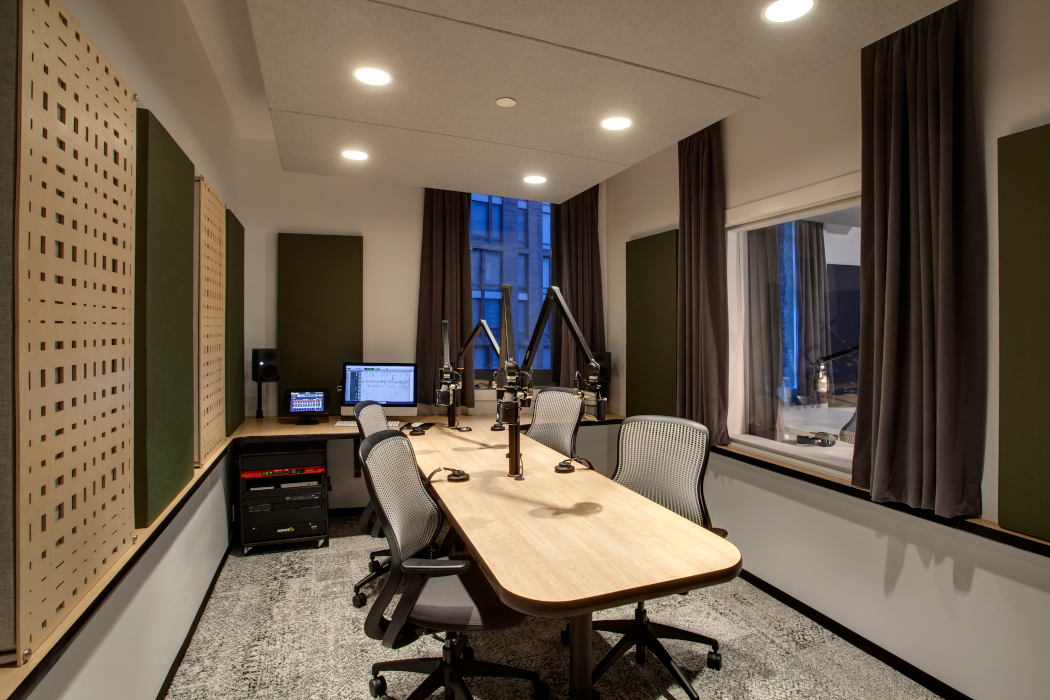
“We were able to leverage a combination of Cat6, Cat6A and fiber connections that gave us everything we needed on day one and [gives us] tons of flexibility as we grow, while drastically reducing the cabling time and costs associated with analog or proprietary digital systems,” Thompson explained.
However, although AV and IT have been on convergent courses for some time, a few missed connections were discovered when SPL began to hook into many of the estimated 1,000 IT drops around the facility. “What happens, I think, is that the IT designers look at a layout but don’t necessarily see what the AV people see in it,” Gajowniczek said diplomatically. “They don’t see, for instance, how Dante connects to it.”
Down To Business
Gimlet Media’s business side is as transparent as its production aspects. With an emphasis on collaboration, a large open-office plan is ringed with meeting spaces. The most basic are the Team Rooms, each one currently assigned to the production teams for the top seven podcasts in their corporate portfolio. (Other podcast teams have places in the mostly open-office area.) The integrated AV is sparse: a pair of QSC AD-S6T wall-mounted speakers and an Attero Tech input wallplate compatible with AES67 and Bluetooth. “It’s really for playback and discussions about the shows,” Gajowniczek noted.
The four Edit Lounges are sort of a way station between the office and production sides. “They’re really conference rooms with more technical capability,” Gajowniczek described. That includes offering videoconferencing using a 49-inch LG display, a Logitech C930E 1080p webcam and a Shure MXA310 tabletop microphone array. (SPL’s home base is a short drive from Shure’s headquarters in Niles IL.) “They’ll use [the spaces] for conference rooms, but they can also be used to monitor remote editing sessions, if needed,” he added.
The office’s three huddle rooms each have all of that, as well as a 49-inch LG display, plus ceiling and/or pendant speakers (depending upon the nature of each room’s ceilings and the spaces above them), and a tabletop controller for the QSC network. As with the other collaboration spaces in the office, Google’s G Suite service is used for room scheduling.
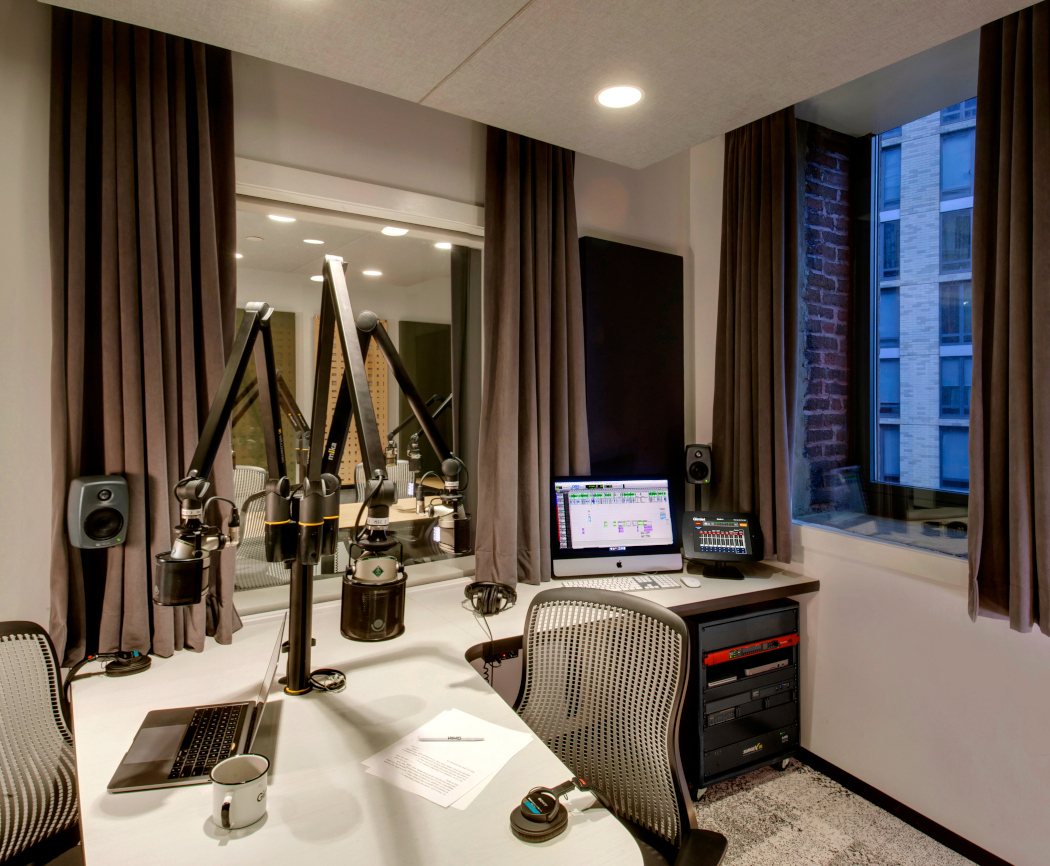
Four conference rooms up the stakes with Shure MXA910W ceiling-array microphone systems, QSC PTZ cameras for AV-to-USB bridging and three 65-inch LG displays. These are boardroom-level spaces that boast a broad range of connectivity, including inputs for XLR and RCA jacks on an Attero Tech 4×2 wallplate to play back audio from even the most vintage portable audio recorders. “Podcast audio comes from a huge plethora of sources—mobile recorders, computers, laptops—and these rooms can take it all in,” Gajowniczek confirmed.
If the conference and huddle rooms represent the buttoned-down side of Gimlet Media, another space reflects its kinship with Silicon Valley. The Garage is a kind of conference-room-meets-town-hall space. It can act as a meeting space of its own, given that it’s fitted with four QSC surface-mount speakers and the earlier-described mic array, webcam and conferencing system, as well as a pair of 80-inch NEC E805 commercial displays. Alternatively, it can act as an additional conference space or an overflow area for the Café, which is an adjacent space that has much the same AV kit (albeit just one 49-inch LG display) but also a Shure ULXD wireless microphone system, creating a pair of all-hands meeting spaces.
“[All of it] fits into what is largely an open-plan office, but with a lot of spaces that also have multiple uses and are all connected,” Gajowniczek summarized.
All the rooms on both sides are monitored centrally and remotely through the Core. “If anything in any room goes offline for more than five minutes, a room-by-room monitor display in the main IT closet turns that room’s number red,” he described. “Austin and I are automatically alerted by email.” Gajowniczek continued, “If the main processor goes down, the other one kicks in in less than 10 seconds.”
Sound Control
Connectivity is thematic to Gimlet Media’s space. Every room is connected to every other through one of two IT closets, five IT switches and eight Catalyst 3650 AV switches on the floor, linked by Cat6 wire to the Q-SYS Core running over four separate virtual local area networks (VLANs). Most of what runs on those networks is audio—the most common currency of podcasts—but Gajowniczek said that video would be added to the mix in the near future. “Most producers are doing some kind of video already, even if it’s just a webcam in their basement, for live streaming of their podcasts,” he explained. “Podcasts are moving toward a live-streaming future, and that will include video.”
Not surprisingly, then, the quality of sound was of primary importance. Thompson brought in noted acoustical firm Walters-Storyk Design Group (WSDG), which designed the studios, production rooms and the flagship conference room. On the office side, the main acoustical issues centered on managing the noise transmission from the two large HVAC systems in the floor’s mechanical room. WSDG measured and analyzed the noise data and made recommendations to Gimlet Media’s mechanical engineers about what could be done to diminish the noise radiating to adjacent spaces. Those recommendations included remounting the HVAC units on isolation springs and adding strategic bends and turns to the ducting, which was also internally insulated to reduce noise.
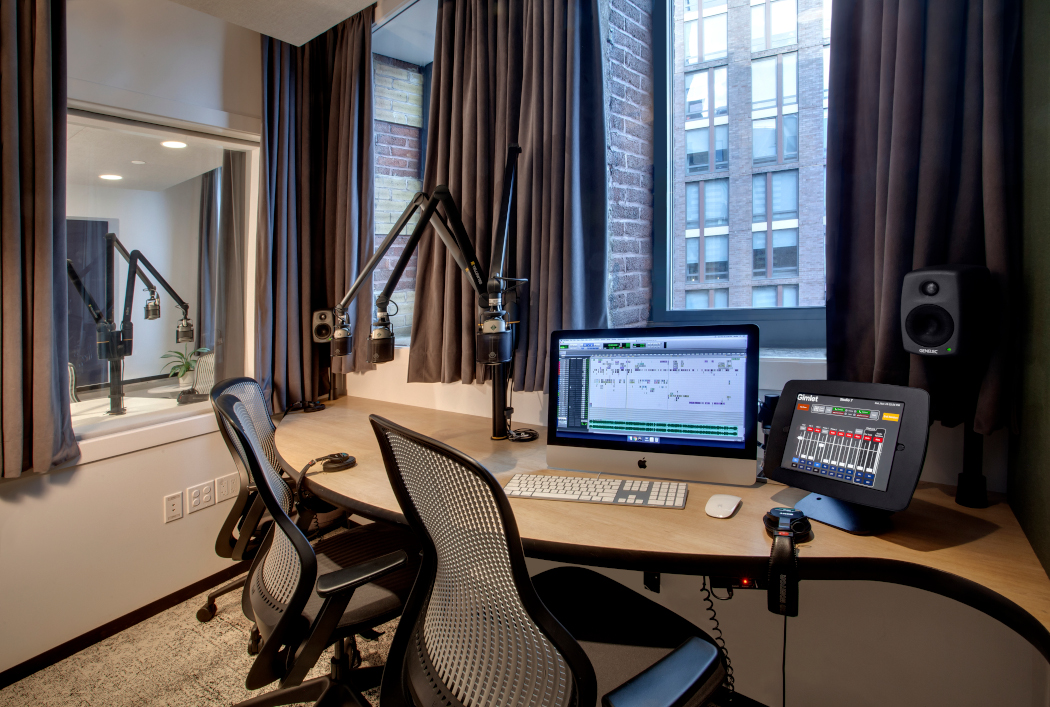
On the production side, WSDG’s Principal, John Storyk, took on what seemed like a relatively straightforward mission, but one that quickly revealed the nuances of podcast production. “What surprised us was the wide variety of the workflows,” he recalled. “They might spend 50 hours on a 30-minute podcast, with lots of outside sources—phone interviews, music and so on.”
Although all the rooms are interconnected in terms of AV and data, the main challenge for their acoustics, by contrast, was to get them separated to avoid noise transfer between rooms—including between the main studio and the largest conference room, which happen to be adjacent. With space at a premium (as it is everywhere in New York NY), there was no way to isolate the spaces with distance between rooms; therefore, each of the 13 production rooms was individually physically decoupled, using room-in-a-room construction techniques. (The recording studio used additional isolated-floor construction, as well, due to the additional noise being generated from that suite.) Once that was settled, though, other acoustical issues became apparent. How to manage low frequencies in small rooms with stiff walls? The answer: absorption via membranes from Arithmetic Design, tuned for LFE in each room. Reflections from surfaces such as the windows in many of the rooms? Cloth-wrapped wall and ceiling absorbers, or perforated panels for diffusion.
On the office side, SPL did some of its own acoustical control. For instance, in the Garage space, which has a glass, garage-type door and hard-surfaced walls, absorptive cloud panels are suspended from the ceiling. Sound masking is also available, processed via a plugin for the Core and emitted by the 39 pendant speakers distributed in conference areas; ambient-sound measurement, fed back to the plugin, is through Shure MX202 Microflex overhead condenser mics.
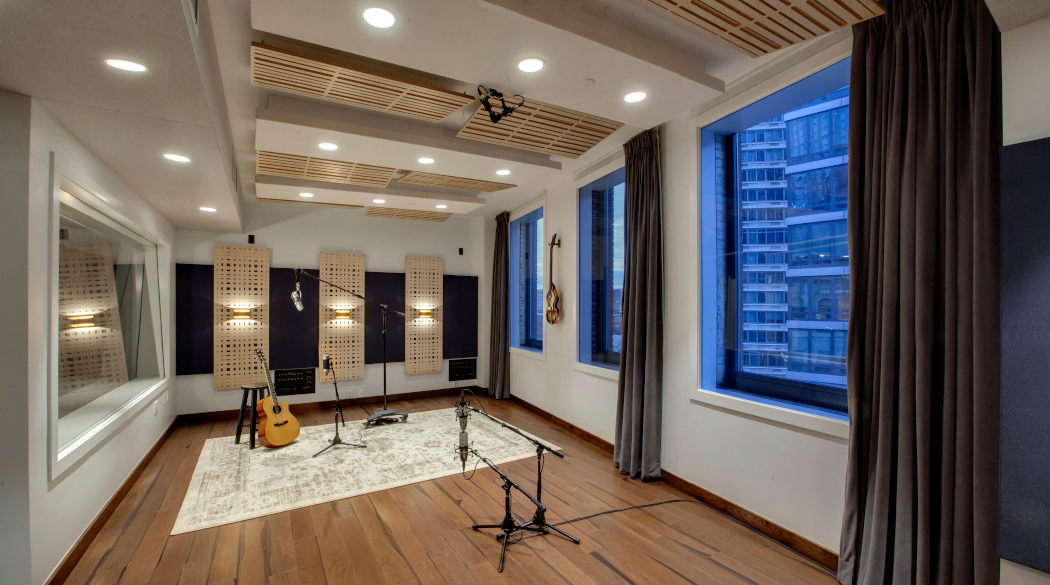
But what might have been the most elaborate challenge of all was the requirement for all the rooms to have an identical sonic signature; compounding the challenge was that each room had slightly different dimensions, due to the fact that they align along an angled exterior wall of the building. “In designing recording studios, you usually want each room to have its own acoustical characteristics,” Storyk, who famously designed Jimi Hendrix’s Electric Lady Studios, explained, “but this was the opposite.” He continued, “Podcast producers will often have to move between production rooms during the course of making a single podcast, so each room had to have the same sound characteristics.”
After all the initial acoustical treatments had been installed, a fast Fourier transform (FFT) was performed on each production room, which converts a consistent test signal into individual spectral components through which each room’s frequency response across a defined spectrum can be measured. The FFTs revealed what slight acoustical-treatment tweaking each space required to make all of them sonically identical.
The New Paradigm
Gimlet Media’s new headquarters could be the paradigm for the evolving media industry, with the line between business and production being reduced to something as thin as the Cat6 cables that link all the spaces. It makes ultra-efficient use of the space—the production studios’ use of iPads instead of large conventional consoles enabled the company to increase the number of those rooms and, thus, its productivity—while the business side of the company can literally listen in as its content is created.
All of this came at a cost, of course; the build-out of the recording studios from start to finish was around $500 per square foot. However, in addition to having a seamless ecosphere for making and monetizing content, Gimlet Media also has a showcase facility for the lifeblood of any new-media company: investment capital. “Doing all of this involved some risk, and it definitely wasn’t the easy way out,” Thompson admitted. “There is a lot of innovation and a good amount of uncharted water here. But the rewards have been worth it. Now, I spend more of my time focusing on improvements and new feature releases, rather than troubleshooting and upkeep, and producers can focus on making great stories, rather than learning how to use complicated equipment.”
EQUIPMENT
Server Room – Racks
2 Chief NAPDV2420PC 20A PDUs
1 Furman ASD-120 2.0 rackmount power-distribution system
4 Middle Atlantic BGR-4132LRD multi-bay racks
2 Tripp Lite PDUMV30NETLX 2.9kW switched PDUs
2 Tripp Lite SU3000RTXLCD3N 2.7kW double-conversion UPSes
Server Room – Gear
1 AMX NMX-ACC-N9206 2RU rackmount cage
5 AMX NMX-ENC-N2312-C 4K ultra-HD video-over-IP card encoders
1 Attero Tech unD4I-L 4-input Dante interface
2 BrightSign HD223 standard I/O players
1 Planar Helium PCT2235 22″ touchscreen monitor
4 QSC CDN64 Dante audio bridge cards
2 QSC Core 510i Q-SYS integrated core processors
2 QSC Core 5200 next-generation enterprise cores
6 QSC CXD8.4Qn networked amps
Electrical – Lighting Control
1 ETC DRd-12-24-277 24-channel install dimming rack w/Paradigm
14 ETC ELTS21D2776 6-channel transfer switches
4 ETC PI1004-5 Paradigm 4-button control stations
7 ETC P-OCC Paradigm occupancy vacancy sensors
Team Rooms (7 Rooms)
7 Attero Tech unA6IO-BT AES67 audio interfaces w/Bluetooth
14 QSC AD-S6T-WH surface-mount speakers
7 QSC WCP-1 rotary potentiometer controls
Edit Lounge (4 Rooms)
4 AMX NMX-DEC-N2322 4K ultra-HD video-over-IP standalone decoders
4 Attero Tech unA6IO AES67 audio interfaces
4 Chief FCAV1U Fusion pull-out accessories
4 Chief MTM1U medium Fusion micro-adjustable tilt wall mounts
4 LG 49LV340C 49″ Commercial HDTVs
4 Logitech C930e 1080p HD webcams
8 QSC AD-S6T-WH surface-mount speakers
4 QSC I/O-USB audio/video bridges
4 QSC TSC-80tw-G2-BK 8″ tabletop system controllers
4 Shure MXA310B table array mics w/Shure DSP utilities (black)
Interview Room (1 Room)
1 AMX NMX-DEC-N2322 4K ultra-HD video-over-IP standalone decoder
1 Chief FCAV1U Fusion pull-out accessory
1 Chief MTM1U medium Fusion micro-adjustable tilt wall mount
1 LG 49LV340C 49″ Commercial HDTV
1 QSC TSC-47w-G2-BK wall-mount system controller
Huddle Rooms (3 Rooms)
3 Attero Tech unA6IO AES67 audio interfaces
2 Chief FCAV1U Fusion pull-out accessories
2 Chief MTM1U medium Fusion micro-adjustable tilt wall mounts
1 LG 43LV340C 43″ Commercial HDTV
1 LG 49LV340C 49″ Commercial HDTV
2 QSC AD-C6T-WH 6.5″ ceiling-mount speakers
4 QSC AD-P4T-WH 4.5″ pendant-mount speakers
3 QSC TSC-80tw-G2-BK 8″ tabletop system controllers
3 Shure MXA310B table array mics w/Shure DSP utilities (black)
Conference Rooms (3 Rooms)
3 AMX NMX-DEC-N2322 4K ultra-HD video-over-IP standalone decoders
1 AMX NMX-ENC-N2312 4K ultra-HD video-over-IP standalone encoder
1 Attero Tech unA6IO AES67 audio interface
2 Attero Tech unAIO2x2+ AES67 networked audio interfaces – 2×2 mic/line I/O
3 Chief FCAV1U Fusion pull-out accessories
3 Chief MTM1U medium Fusion micro-adjustable tilt wall mounts
3 LG 65LX341C 65″ Commercial HDTVs
12 QSC AD-C6T-WH 6.5″ ceiling-mount speakers
3 QSC I/O-USB audio/video bridges
3 QSC PTZ 12×72 conference cameras
3 QSC TSC-80tw-G2-BK 8″ tabletop system controllers
3 Shure MXA910W 24″ ceiling array mics w/Shure DSP utilities
Large Conference Room
2 AMX NMX-DEC-N2322 4K ultra-HD video-over-IP standalone decoders
1 AMX NMX-ENC-N2312 4K ultra-HD video-over-IP standalone encoder
1 Attero Tech unAIO2x2+ AES67 networked audio interface – 2×2 mic/line I/O
2 Chief LVS1U ConnexSys videowall landscape mounting systems w/rails
1 Kramer VIA GO wireless presentation solution
2 NEC E805 80″ LED backlit commercial displays
8 QSC AD-C6T-WH 6.5″ ceiling-mount speakers
1 QSC I/O-USB audio/video bridge
1 QSC PTZ 12×72 conference camera
1 QSC TSC-116tw-G2-BK 11.5″ tabletop system controller
1 Shure MXA910W 24″ ceiling array mic w/Shure DSP utilities
The Garage
2 AMX NMX-DEC-N2322 4K ultra-HD video-over-IP standalone decoders
1 AMX NMX-ENC-N2312 4K ultra-HD video-over-IP standalone encoder
1 Attero Tech unA6IO AES67 audio interface
1 Attero Tech unXP2O single-gang, 2-out, analog expansion wallplate
2 Chief LVS1U ConnexSys videowall landscape mounting systems w/rails
1 Kramer VIA GO wireless presentation solution
2 NEC E805 80″ commercial displays
4 QSC AD-S8T-WH surface-mount speakers
1 QSC I/O-USB audio/video bridge
1 QSC PTZ 12×72 conference camera
1 QSC TSC-80w-G2-BK 8″ wall-mount system controller
1 Shure MXA910W 24″ ceiling array mic w/Shure DSP utilities
Café
2 AMX NMX-DEC-N2322 4K ultra-HD video-over-IP standalone decoders
2 AMX NMX-ENC-N2312-C 4K ultra-HD video-over-IP card encoders
1 Attero Tech unA6IO AES67 audio interface
1 Attero Tech unXP2O single-gang, 2-out, analog expansion wallplate
1 Chief TS318TU swivel TV mounting system
1 Kramer VIA GO wireless presentation solution
1 LG 49LV340C 49″ Commercial HDTV
4 QSC AD-S10T-WH surface-mount speakers
2 QSC AD-S8T-WH surface-mount speakers
2 QSC AD-P6T-WH 6.5″ pendant-mount speakers
1 QSC I/O-USB audio/video bridge
1 QSC PTZ 12×72 conference camera
1 Shure ULXD4D dual-channel digital wireless receiver
2 Shure ULXD2/K8B handheld transmitters w/KSM8 mic capsules
Open Office Plan
39 QSC AD-P4T-WH 4.5″ pendant-mount speakers
4 Shure MX202WP/N off-white mini-condenser mics
4 Shure R183W replacement omnidirectional cartridges
Studio Gear – Server Room
2 Studio Technologies Model 5401 Dante master clocks
Studio Gear – Studio/Control Room
1 Bryston 2B LP PRO dual-channel amp
4 Focusrite Pro RedNet MP8R 8-channel mic pres and A/Ds
1 Grace Design m905 reference monitor controller
1 Lynx Aurora (n) 16-DNT 16-channel, 24-bit/192KHZ A/D D/A converter
2 Neumann KH 310 8.25″ 3-way powered studio monitors
1 Neumann KH 805 10″ powered studio sub
1 Radial Engineering Workhorse Powerhouse 500 Series power-rack
2 Sennheiser e901 boundary condenser mics
1 Sound Anchors ADJ2-44 adjustable 44″ monitor stand
1 SurgeX SU-1000Li UPS + protection
2 Tripp Lite RS-1215-RA 1RU rackmount power strips, 120V, 15A
1 Xilica XP-4080 processor
Studio Gear – Studios 1-12
13 Apple iMac 4K w/Protools 12 and DVS
13 Apple iPad Pro 10.5″
13 Bosstab Fusion freestanding iPad kiosk stands
5 Focusrite Pro RedNet AM2 compact, PoE-supplied stereo analog output devices
11 Focusrite Pro RedNet MP8R 8-channel mic pres and A/Ds
14 Genelec 8010A 3″ powered studio monitors
10 Neumann KH 80 DSP 4″ powered studio monitors
12 QSC I/O-8 Flex Q-SYS channel expanders
13 Radial Engineering JPC computer direct boxes
10 RDL RU-ADA8D audio distribution amps
16 Sescom iPhone-Mic-1 TRRS-to-XLR mic and 3.5mm monitoring jack cables
41 Sony MDR7506 professional large-diaphragm headphones
10 SurgeX SU-1000Li UPSes + protection
10 Tripp Lite RS-1215-RA 1RU rackmount power strips, 120V, 15A
41 Whirlwind HAUC under-counter, active, stereo headphone control boxes
19 YellowTec YT3245 m!ka MMS pole desktop mounting kits
32 YellowTec YT3601 m!ka mic arms
41 YellowTec YT3613 m!ka MMS pole adapters
19 YellowTec YT3640 MMS system poles
9 YellowTec YT3701 m!ka mic arm XLs
List is edited from information supplied by Sound, Production & Lighting.
